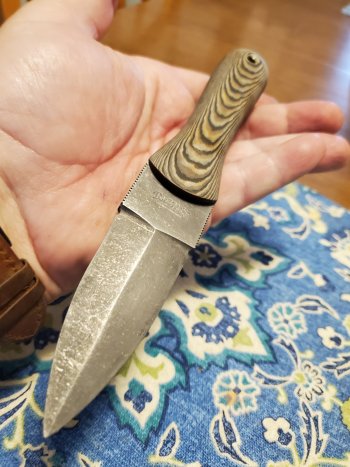Let me apologize if I have muddied the waters needlessly. It is just that I mostly browse forums for topics with subjects that interest me, and while I have a look at most any dagger thread, I rarely post myself. So, I also apologize if my enthusiasm has caused me to hijack Kev’s thread, the post of pics in somebody else’s thread was probably a bit gauche, I just wanted to give some examples of what I am referring to, but it shouldn’t be about me or my work.
John, the first thing to understand about daggers is their primary function and how it differs radically from knives. Think of fine saw or chisel cuts (knives) versus effortless piercing like a sewing machine needle (daggers). I think the number one thing that knifemakers do to make their daggers attempts more difficult than they have to be, is to try to make a double edged knife, or essentially two knives joined back to back. This is understandable since we are, after all, “knife” makers. But his approach leaves us not thinking as three dimensionally as we need to for daggers, and leaves us making blades that are too thin for the function and the shape. A ¼” or less thick dagger blade will be five times more difficult to do and will not feel, perform or look much like a functional dagger after all that work is done.
The higher the midrib, the stronger and more functional it will be, and the proud lines it will create will keep themselves straight and crisp. The shape really should taper on both planes, both in thickness, and in profile. But the trick is that the tip does not thin out so that it maintains maximum strength for penetration, or armor piercing, if you will. This requires abandoning many of the grinding techniques deigned for a consistent angled flat grind for knives, as a good dagger will have what I refer to as a helical grind. A grind that starts at a lower angle and increases at the tip until your flattened diamond cross section actually steepens to a square cross section. Grinding the blade like a knife will result in a thin and week tip, the most critical performing part of a dagger.
There are countless other things to consider, but every one of my students have the light bulb go on once they let go of knifemaking and surrender to the fact that it is a dagger class. It takes me about a week to retrain knifemakers to make daggers, then the easier things can happen. Like polishing. You can polish a dagger in half the time as a knife.
I guess there are double edged knives, but I have never had an interest in them, but daggers are not knives, they are daggers, which is a very different beast. Swords are even more different altogether, and although swords and daggers often accompany each, they are still different which is obvious for the fact that they do accompany each other so that the different functions can complement the other.






